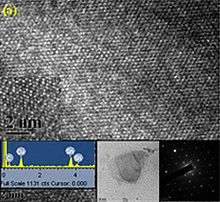Stanene
Stanene[2][3][4] is a 2D material and a 2D topological insulator. It is composed of tin atoms arranged in a single, hexagonal layer, in a manner similar to graphene. Its name combines stannum (the Latin name for tin) with the suffix -ene used by graphene.[5]

Stanene was theoretically predicted to be a 2D topological insulator in 2011,[6] and its functionalized derivations as topological insulators were predicted in 2013.[7] Both may display dissipationless superconductive currents at their edges near room temperature. The addition of fluorine atoms to the tin lattice could extend the operating temperature up to 100 °C.[8] This would make it practical for use in integrated circuits to make smaller, faster and more energy efficient computers.
Synthesis
The synthesis and study of optical properties of stanene was first claimed by researchers at the Indian Institute of Technology Bombay.[9] Stanene synthesis was reported by a second group in 2015, using molecular beam epitaxy on a substrate of bismuth telluride.[10][11] Theoretical research suggested Ag(111) surface may be a good substrate to grow stanene epitaxially.[12] In 2018 the growth of epitaxial 2D stanene on an Ag(111) single crystal template was reported.[13]
Reactivity
First principle calculations have predicted that stanene is very reactive against common air pollutants such as NOx and COx and is able to trap and dissociate them at low temperatures.[14]
References
- Saxena, Sumit; Chaudhary, Raghvendra Pratap; Shukla, Shobha (2016). "Stanene: Atomically Thick Free-standing Layer of 2D Hexagonal Tin". Scientific Reports. 6: 31073. arXiv:1505.05062. Bibcode:2016NatSR...631073S. doi:10.1038/srep31073. PMC 4974617. PMID 27492139.
- Garcia, J. C.; de Lima, D. B.; Assali, L. V. C.; Justo, J. F. (2011). "Group IV graphene- and graphane-like nanosheets". J. Phys. Chem. C. 115 (27): 13242–13246. arXiv:1204.2875. doi:10.1021/jp203657w.
- DOE/SLAC National Accelerator Laboratory (2013-11-21). "Will 2-D tin be the next super material?". Sciencedaily.com. Retrieved 2014-01-10.
- "Will 2-D tin be the next super material?". Phys.org. 21 November 2013. Retrieved 2014-01-10.
- Singh, Ritu (November 24, 2013). "Tin could be the next super material for computer chips". Zeenews.
- Liu, Cheng-Cheng; Jiang, Hua; Yao, Yugui (2011). "Low-energy effective Hamiltonian involving spin-orbit coupling in silicene and two-dimensional germanium and tin". Phys. Rev. B. 19 (84): 195430. arXiv:1108.2933. Bibcode:2011PhRvB..84s5430L. doi:10.1103/PhysRevB.84.195430.
- Xu, Y.; Yan, B.; Zhang, H. J.; Wang, J.; Xu, G.; Tang, P.; Duan, W.; Zhang, S. C. (2013). "Large-Gap Quantum Spin Hall Insulators in Tin Films". Physical Review Letters. 111 (13): 136804. arXiv:1306.3008. Bibcode:2013PhRvL.111m6804X. doi:10.1103/PhysRevLett.111.136804. PMID 24116803.
- "Will 2-D Tin be the Next Super Material?" (Press release). Stanford University: SLAC National Accelerator Laboratory. November 21, 2013.
- Saxena, Sumit; Chaudhary, Raghvendra Pratap; Shukla, Shobha (May 20, 2015), "Stanene: Atomically Thick Free-standing Layer of 2D Hexagonal Tin", Scientific Reports, 6: 31073, arXiv:1505.05062, Bibcode:2016NatSR...631073S, doi:10.1038/srep31073, PMC 4974617, PMID 27492139
- Cesare, Chris (2015). "Physicists announce graphene's latest cousin: stanene". Nature News. 524 (7563): 18. Bibcode:2015Natur.524R..18C. doi:10.1038/nature.2015.18113. PMID 26245561.
- Feng-feng Zhu, Wei-jiong Chen; Xu, Yong; Chun-lei Gao, Dan-dan Guan; Can-hua, Liu; Qian, Dong; Zhang, Shou-Cheng; Jin-feng, Jia (2015). "Epitaxial growth of two-dimensional stanene". Nature Materials. 14 (10): 1020–1025. arXiv:1506.01601. Bibcode:2015NatMa..14.1020Z. doi:10.1038/nmat4384. PMID 26237127.
- Gao, Junfeng; Zhang, Gang; Zhang, Yong-Wei (2016). "Exploring Ag (111) Substrate for Epitaxially Growing Monolayer Stanene: A First-Principles Study". Scientific Reports. 6: 29107. Bibcode:2016NatSR...629107G. doi:10.1038/srep29107. PMC 4931515. PMID 27373464.
- Yuhara, Junji; Fujii, Yuya; Nishino, Kazuki; Isobe, Naoki; Nakatake, Masashi; Xian, Lede; Rubio, Angel; Le Lay, Guy (2018). "Large area planar stanene epitaxially grown on Ag(1 1 1)". 2D Materials. 5 (2): 025002. Bibcode:2018TDM.....5b5002Y. doi:10.1088/2053-1583/aa9ea0.
- Takahashi, L.; Takahashi, K. (2015). "Low temperature pollutant trapping and dissociation over two-dimensional tin". Physical Chemistry Chemical Physics. 17 (33): 21394–21396. Bibcode:2015PCCP...1721394T. doi:10.1039/C5CP03382A. PMID 26226204.
External links
| Wikimedia Commons has media related to Stanene. |
- Choi, Charles Q. (December 4, 2013). "Could Atomically Thin Tin Transform Electronics?". Scientific American.
- Johnson, R. Colin (3 December 2013). "Stanene May Be Better Than Graphene". EE Times.
- Myslewski, Rik (4 December 2013). "OHM MY GOD! Move over graphene, here comes '100% PERFECT' stanene". The Register.
- "Tin-based stanene could conduct electricity with 100 percent efficiency". gizmag. 2013-12-01. Retrieved 2013-12-05.
- Vandenberghe, William (2013-10-25). "Quantum Transport for future Nano-CMOS Applications : TFETs and 2D topological insulators" (PDF). University of Texas at Dallas. Retrieved 2014-01-03.